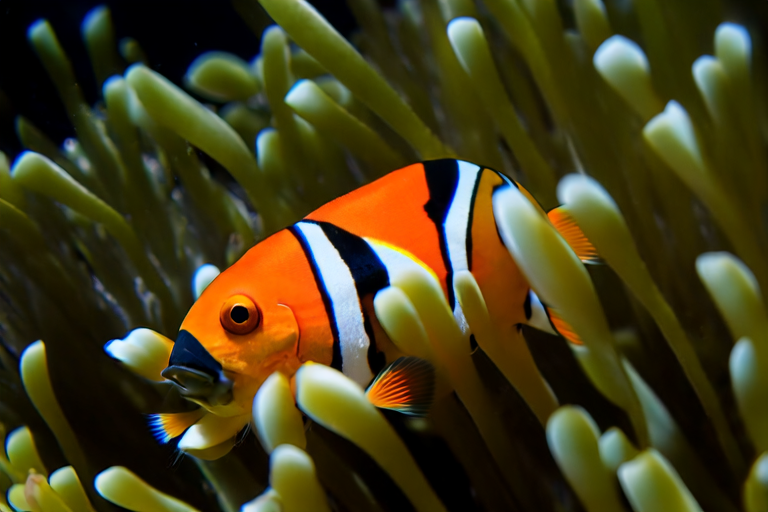5 Fascinating Facts About Clownfish You Didn’t Know

Clownfish are some of the most beloved marine creatures, often featured in movies like Finding Nemo. Their striking colors and charming behavior make them a favorite among both children and adults. But there’s more to these fish than meets the eye. Let’s dive into five fascinating facts about clownfish that you probably didn’t know.
Fact 1: Clownfish Are Natural Chemists
Clownfish have a unique relationship with sea anemones, their primary habitat. These anemones are equipped with stinging cells called nematocysts, which they use to paralyze prey and protect themselves from predators. However, clownfish have evolved to be immune to the anemone’s sting. This adaptation allows them to live safely within the anemone’s tentacles, where they find protection and food.
But here’s where it gets really interesting: recent studies suggest that clownfish may also influence the chemical composition of their host anemones. A study published in The Journal of Experimental Biology found that clownfish can alter the pH levels around the anemone, making the environment less acidic. This could help the anemones thrive in warmer waters, which is particularly important as ocean temperatures rise due to climate change. The clownfish essentially acts as a natural buffer, protecting its home from environmental stress.
Fact 2: Clownfish Are Masters of Disguise
While clownfish are known for their bright orange and white stripes, they also possess remarkable camouflage abilities. When threatened, clownfish can change their coloration to blend in with their surroundings. This ability isn’t just for show; it’s a crucial survival tactic.
Researchers at the University of Queensland discovered that clownfish can adjust the brightness and pattern of their scales to match the background. This adaptation allows them to hide from predators, especially when they venture outside the safety of their anemone homes. The fish achieve this by altering the pigment-producing cells in their skin, a process known as chromatophores. This natural camouflage is a testament to the clownfish’s ingenuity in dealing with threats in their aquatic world.
Fact 3: Clownfish Are Exceptional Parents
Unlike many other fish species, clownfish exhibit a unique parenting style. They are monogamous and share parental duties equally. The female clownfish lays her eggs on a flat surface near their anemone, and both parents guard the eggs until they hatch. During this time, they fan the eggs with their fins to ensure proper oxygenation and keep predators away.
What makes clownfish even more fascinating is their method of determining the sex of their offspring. In most clownfish populations, the largest fish is always the dominant female. If she dies or is removed, the next largest fish undergoes a hormonal transformation and becomes the new female. This ensures the continuation of the species, as the male will pair up with the new female to produce more offspring. This flexible reproductive strategy is a marvel of evolutionary biology.
Fact 4: Clownfish Have a Unique Communication System
Communication in clownfish goes beyond simple sounds. They use a combination of visual cues, body movements, and even chemical signals to interact with each other. One of the most intriguing aspects of their communication is the use of electric fields.
Recent research has shown that clownfish can detect weak electric fields generated by their peers. These fields are produced through a process called electroreception, which helps the fish navigate and communicate in their dimly lit underwater environments. This system allows them to locate potential mates, avoid conflicts, and coordinate group behaviors without relying solely on sight. It’s like having a built-in GPS system that guides them through the complex reef ecosystems.
Fact 5: Clownfish Can Survive Without Anemones
While clownfish are famously associated with sea anemones, they can survive without them under certain conditions. This discovery challenges the long-held belief that clownfish are entirely dependent on their anemone hosts.
A study conducted by researchers at James Cook University found that clownfish can thrive in areas where sea anemones are scarce or absent. In these cases, the fish adapt by forming small groups and defending territories against other clownfish. They also feed on plankton and small crustaceans, demonstrating their versatility in finding food sources. This flexibility in habitat and diet shows that while anemones provide a significant advantage, clownfish are capable of surviving independently.
However, it’s important to note that living without anemones comes with trade-offs. Clownfish without anemones are more vulnerable to predators and face greater competition for resources. Nonetheless, their ability to adapt to different environments underscores their resilience and resourcefulness.
Conclusion
Clownfish are not only adorable and colorful but also incredibly adaptable and intelligent. From their unique relationships with sea anemones to their sophisticated communication systems, there’s always something new to learn about these fascinating creatures. Whether you’re a marine biologist or simply someone who loves watching fish, clownfish offer endless fascination and insight into the wonders of the underwater world.
Next time you see a clownfish, take a moment to appreciate the complexity behind its vibrant appearance and playful demeanor. Who knows? You might just discover something new and exciting about these amazing fish.
